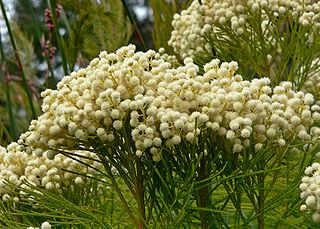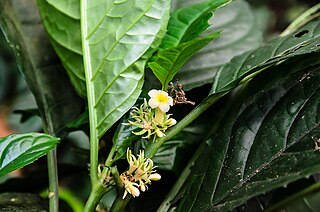
The order Lamiales are an order in the asterid group of dicotyledonous flowering plants. It includes about 23,810 species, 1,059 genera, and is divided into about 25 families. These families include Acanthaceae, Bignoniaceae, Byblidaceae, Calceolariaceae, Carlemanniaceae, Gesneriaceae, Lamiaceae, Lentibulariaceae, Linderniaceae, Martyniaceae, Mazaceae, Oleaceae, Orobanchaceae, Paulowniaceae, Pedaliaceae, Peltantheraceae, Phrymaceae, Plantaginaceae, Plocospermataceae, Schlegeliaceae, Scrophulariaceae, Stilbaceae, Tetrachondraceae, Thomandersiaceae, Verbenaceae.

Flowering plants are plants that bear flowers and fruits, and form the clade Angiospermae, commonly called angiosperms. They include all forbs, grasses and grass-like plants, a vast majority of broad-leaved trees, shrubs and vines, and most aquatic plants. The term "angiosperm" is derived from the Greek words ἀγγεῖον / angeion and σπέρμα / sperma ('seed'), meaning that the seeds are enclosed within a fruit. They are by far the most diverse group of land plants with 64 orders, 416 families, approximately 13,000 known genera and 300,000 known species. Angiosperms were formerly called Magnoliophyta.

The Solanales are an order of flowering plants, included in the asterid group of dicotyledons. Some older sources used the name Polemoniales for this order.

The Vitaceae are a family of flowering plants, with 14 genera and around 910 known species, including common plants such as grapevines and Virginia creeper. The family name is derived from the genus Vitis.

The Restionaceae, also called restiads and restios, are a family of flowering plants native to the Southern Hemisphere; they vary from a few centimeters to 3 meters in height. Following the APG IV (2016): the family now includes the former families Anarthriaceae, Centrolepidaceae and Lyginiaceae, and as such includes 51 genera with 572 known species. Based on evidence from fossil pollen, the Restionaceae likely originated more than 65 million years ago during the Late Cretaceous period, when the southern continents were still part of Gondwana.

Linaceae is a family of flowering plants. The family is cosmopolitan, and includes about 250 species in 14 genera, classified into two subfamilies: the Linoideae and Hugonioideae. Leaves of the Linaceae are always simple; arrangement varies from alternate to opposite or whorled. The hermaphroditic, actinomorphic flowers are pentameric or, very rarely, tetrameric.

Austrobaileya is the sole genus consisting of a single species that constitutes the entire flowering plant family Austrobaileyaceae. The species Austrobaileya scandens grows naturally only in the Wet Tropics rainforests of northeastern Queensland, Australia.

Sesamum is a genus of about 20 species in the flowering plant family Pedaliaceae. The plants are annual or perennial herbs with edible seeds. The best-known member of the genus is sesame, Sesamum indicum, the source of sesame seeds. The species are primarily African, with some species occurring in India, Sri Lanka, and China. The origin of S. indicum is uncertain, as it is widely cultivated and naturalized in tropical regions. The genus is closely related to the strictly African genus Ceratotheca and is itself probably African in origin.

In the APG IV system (2016) for the classification of flowering plants, the name asterids denotes a clade. Asterids is the largest group of flowering plants, with more than 80,000 species, about a third of the total flowering plant species. Well-known plants in this clade include the common daisy, forget-me-nots, nightshades, the common sunflower, petunias, yacon, morning glory, lettuce, sweet potato, coffee, lavender, lilac, olive, jasmine, honeysuckle, ash tree, teak, snapdragon, sesame, psyllium, garden sage, table herbs such as mint, basil, and rosemary, and rainforest trees such as Brazil nut.

Myrothamnus is a genus of flowering plants, consisting of two species of small xerophytic shrubs, in the southern parts of tropical Africa and in Madagascar. Myrothamnus is recognized as the only genus in the family Myrothamnaceae.

Martyniaceae is a family of flowering plants in the Lamiales order that are restricted to the Americas. The family was included in Pedaliaceae in the Cronquist system but is recognized as a separate family by the Angiosperm Phylogeny Group on the basis of phylogenetic studies that show that the two families are not closely related. Both families are characterized by having mucilaginous hairs — which give the stems and leaves a slimy or clammy feel — and fruits with hooks or horns. Some members of the genus Proboscidea are known as "unicorn plant" or "devil's claw" because of their horned seed capsules.
Plant taxonomy is the science that finds, identifies, describes, classifies, and names plants. It is one of the main branches of taxonomy.

The Balanophoraceae are a subtropical to tropical family of obligate parasitic flowering plants, notable for their unusual development and formerly obscure affinities. In the broadest circumscription, the family consists of 16 genera. Alternatively, three genera may be split off into the segregate family Mystropetalaceae.

Caryophyllales is a diverse and heterogeneous order of flowering plants that includes the cacti, carnations, amaranths, ice plants, beets, and many carnivorous plants. Many members are succulent, having fleshy stems or leaves. The betalain pigments are unique in plants of this order and occur in all its families with the exception of Caryophyllaceae and Molluginaceae.

Bruniaceae is a family of shrubs native to the cape region of South Africa. They are mostly restricted to the Cape Province, but a small number of species occur in KwaZulu-Natal.

The Carlemanniaceae are a tropical East Asian and Southeast Asian family of subshrub to herbaceous perennial flowering plants with 2 genera. Older systems of plant taxonomy place the two genera, Carlemannia, and Silvianthus within the Caprifoliaceae or the Rubiaceae. The Angiosperm Phylogeny Group classification of 2003 places the group in the Lamiales, as a plant family more closely related to the Oleaceae than to the Caprifoliaceae.

The Torricelliaceae are a family of trees native to Madagascar and southwest Asia. It contains three genera, Aralidium, Melanophylla and Torricellia. Under the APG II system, each of these genera was placed in its own family, but with the proviso that "Some of the families are monogeneric and could possibly be merged when well-supported sister-group relationships have been established." Such a relationship was established for these three genera in 2004. In the APG III system, these three genera constitute the family Torricelliaceae.

Ceratotheca sesamoides is an annual flowering plant in the genus Ceratotheca. It is indigenous to Africa, and grows both as a wild and locally-cultivated species, and is colloquially referred to as false sesame owing to its marked similarities with common sesame. The plant is most commonly cultivated in the African savannah and other semi-arid areas on the continent, and is found across Africa in both tropical and sub-tropical latitudes, usually growing in sandier soils south of the Sahara. It can be identified by numerous hairs on the stem; its pinkish flowers, often showing brown and purple markings; and a sub-erect growth habit. The leaves and flowers are often consumed as a vegetable or used in sauces. The leaves are thought to have medicinal properties, while the seeds can be used to produce cooking oil. Despite its many uses and increasing domestication at a local level, the plant remains predominantly underused and undervalued.

Sesamum alatum is a species of flowering plant in the Pedaliaceae. It is in the same genus as sesame. In English it is called winged-seed sesame. Its native range spans from Western Sahara to Egypt and south to KwaZulu-Natal in South Africa.

Rogeria is a genus of plants in the Pedaliaceae family consisting of several species, with a native range extending from the island of Cape Verde to Eritrea, Namibia to the Cape Provinces.





























